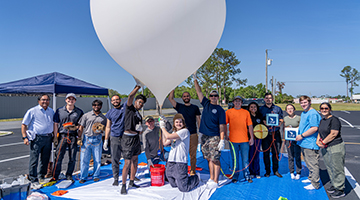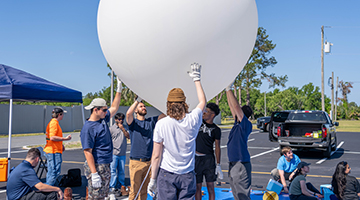UNF team selected by NASA to investigate sun’s radiation impacts this summer
 The University of North Florida is one of 21 universities selected by NASA’s Nationwide Ballooning Program to collect and report scientific data this summer.
The University of North Florida is one of 21 universities selected by NASA’s Nationwide Ballooning Program to collect and report scientific data this summer.
The mission this spring and summer involved a UNF student team working together to measure radiation from the sun’s coronal mass ejections. The team is led by the UNF physics faculty, Dr. Nirmal Patel, as a PI, and mentored by Dr. Hemani Kaushal, an electrical engineering assistant professor.
NASA is interested in studying coronal mass ejections because the sun is currently experiencing its maximum solar period, an approximately 11-year cycle during which it swaps magnetic fields and transitions between low and high magnetic activities. This solar activity significantly influences space conditions, known as space weather, which can impact satellites, power grids, visibility of auroras, communication and navigation systems such as radio and GPS.
The student team includes seven UNF students who received NASA-Florida Space Grant Consortium funded scholarships: Brody Chitwood, Charles Fritts, Aryan Patel, Diya Patel, Alex Gates, Eliel Ortiz and Clement Wurtz. The team also includes several members of the space science engineering club: Corey Cole, David Schineis, Stella Brantley, Austin Hess, Henery, Paul Bongato, Jon Dallaris, David Williams and others.
Diya’s role involved payload development, hardware integration and functionality.
“What truly sets this experience apart is the opportunity to work with an interdisciplinary team of exceptionally talented faculty and students, each contributing a unique expertise,” said Diya. “I am incredibly grateful for this opportunity.”
 While individual contributions like Diya’s were vital, the success of the mission was truly a collective effort. The members of UNF Space Science club measured the sun’s radiation using a Geiger Muller tube and scintillation detector payloads. Flight data including pressure, temperature, GPS coordinates and speed were recorded using the UNF Osprey flight data recorder payload. The team also developed and tested a LoRa-based transmitter-receiver payload to collect and monitor real-time flight data. The team successfully made three balloon flights from Perry, Live Oak and Madison, Florida, and measured the cosmic radiation at more than 92,000 feet, a higher altitude than the team had reached before.
While individual contributions like Diya’s were vital, the success of the mission was truly a collective effort. The members of UNF Space Science club measured the sun’s radiation using a Geiger Muller tube and scintillation detector payloads. Flight data including pressure, temperature, GPS coordinates and speed were recorded using the UNF Osprey flight data recorder payload. The team also developed and tested a LoRa-based transmitter-receiver payload to collect and monitor real-time flight data. The team successfully made three balloon flights from Perry, Live Oak and Madison, Florida, and measured the cosmic radiation at more than 92,000 feet, a higher altitude than the team had reached before.
UNF previously participated in NASA’s National Eclipse Ballooning Project during the 2023 annular and 2024 total solar eclipses. This innovative project allows UNF students to engage in a NASA mission-like adventure of data acquisition and analysis through scientific ballooning. The previous projects found that the ozone gas concentration in the stratosphere decreased during the solar eclipse because of the decrease in ultraviolet sunlight.
Patel has been actively involved in launching ozone sensor payloads using NASA’s High Altitude Student Platform (NASA-HASP) balloon flights every year since 2008, engaging numerous science and engineering students annually in his project at UNF and NASA's Columbia Scientific Balloon Facility in Texas and New Mexico. The NASA projects brought a variety of majors, showcasing the strength of interdisciplinary collaboration among STEM subjects and the dedication of students involved.
